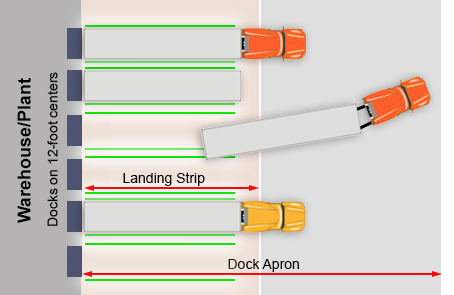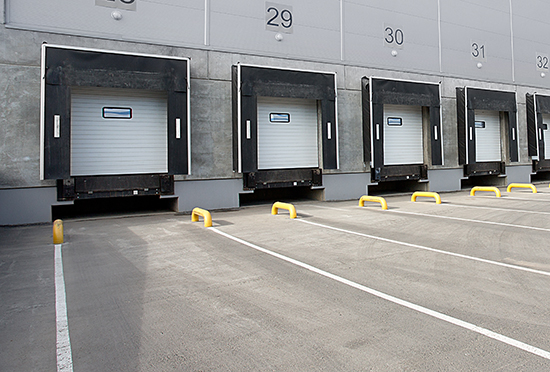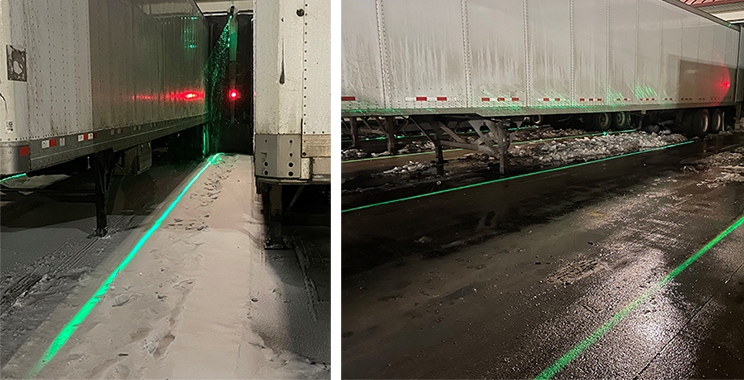How to Help Drivers Park Faster & Safer at Your Truck Docks
Improve shipping and receiving operations by guiding drivers to the right dock, angle and position

Warehouse managers tend to focus on internal processes, equipment and systems, but making your dock apron and loading zone more efficient will save time, money and damage. Truck drivers who can’t clearly see the right dock in darkness or poor weather can’t maneuver effectively or square up to the dock quickly. They often must back in and out multiple times. Helping drivers align and organize will improve the entire flow of your shipping and receiving operation.
The problems with truck & dock alignment
Not every driver can visually align their trailers to the dock without visual guidance, and the best guides are clear lines. If drivers have to to stop, evaluate and decide if they’re backing to the dock square, it eats into valuable time and takes up the dock slot. This chips away at warehouse productivity daily–and over time.
The apron space that leads to your dock door might not always be under your control, but organizing and optimizing it can help you work better. Organizing it for the flow of inbound trucks, truck/trailer size and organization is critical. Even if it’s an existing facility and you can’t expand it, you can optimize the way it’s used. The type and size of trucks you may need to dock aren’t necessarily in your control.
Apron space is there for trucks to maneuver toward your docks. Assisting drivers so they can get this right is critical. Guidance is highly recommended to reduce the time it takes to park a truck–and the chances for an accident. If inbound drivers can park squarely the first time, it reduces wasted time for both them and your warehouse crew.
The process

In the above illustration, drivers approach the apron, then back onto the landing strip to align their trucks with the specified dock door. If the landing zone isn’t marked to provide guidance, they must “eyeball” the process. This takes extra time and causes problems when the docks are busy and in demand.

In this example, drivers are provided guide lines to help drivers align their trucks and park squarely and more safely. Guidance also helps drivers do the job faster, which means less dwell time at your docks and more time loading and unloading.
Laser dock line projectors vs. painted lines

Above: painted lines with guardrails at the dock area.
Painted lines are absolutely better than nothing. Drivers will tell you that just a little assistance helps them square their truck through the apron and landing strip so that they align with the right dock door and can park square against the dock itself. When they’re forced to eyeball it, it takes longer and they sometimes have to try more than once. Painted lines work, but you should consider a more dynamic solution: laser line projectors.
Projectors let you control when and where lines appear. You can turn on the projectors only for your active docks, for instance–or even the one dock door you want a particular truck to park at.
If you’re operating at night, early mornings or beneath a cover, your painted lines may not be visible to drivers, even if the dock’s landing strip is well-lit.
Projected lines show atop debris or snow, while painted lines are covered up and invisible while painted lines will be covered.
Both laser lights and paint need maintenance. You’ll have to re-stripe your lot regularly to keep those lines fresh and visible. Projected lines, you will need to power them and either manually or automatically activate them when they’re needed.
Laser guide line questions and answers
- How’s the maintenance load? Laser lines never have to be repainted or otherwise maintained. Also: the projectors don’t require maintenance.
- How long does the light last? It’s rated for 18,000 hours of service, which would be more than two years. If you turn it on & off at times you aren’t using it, then it lasts much longer.
- How can we activate them? You can turn them on and off with ease, or use a photoeye to trigger them only when a truck needs to dock.
- How do they perform in weather? They work in pitch black night or the middle of a sunny afternoon. Unlike painted lines, they won’t be covered by snow or debris. They work just as well on a rainy, wet lot as a dry one. They are also visible for drivers in bright sunlight.
- Are they versatile? Yes. You can easily reposition them or move them around if you need to. Just have to position, aim, set and power. You can get them in red or green.
- Can I turn on some, and not others? Absolutely. For instance, you could light up just one lane or a series of them to show drivers where to dock. You can’t do that with taped lines.
- How long are the lines? You can adjust them but there are limits. The higher you mount the light, the longer it can be (generally, the line length can be twice the mounting height and still produce sharp, clear lines in most any conditions. The lines can be longer in lower light situations since they will be brighter.
- What about power? 100-120VAC; Frequency:50/60Hz. They come with a power cable.
- Are these laser lines safe for people to walk over or look at? Yes. They are classified as a 3r device and requires no eye protection or other gear when properly installed.
- Does it work anywhere? Typically most places where you can power and mount it will function; it works indoors and outdoors (It’s IP-65 rated). Also, these projectors have a temperature range of -4 to 104 degrees F.

Above: laser light system (left) projected over snow. Wet ground and rain doesn’t diffuse or reduce the visibility of the laser line, which is also bright and visible in daylight.
A better way for “dusk till dawn” shipping
Finding ways to assist drivers so that they can dock their trucks faster and safer is always worthwhile. Hard barriers, painted lines, or manual assistance/guidance are also good alternatives to unmarked lots; all options can are useful in making your docking and truck operations safe and efficient.
More resources
- DockRight Laser Line Projector
- Download our Guide to Loading Dock Operations
- OSHA Requirements for Better Loading Dock Fall Protection
Scott Stone is Cisco-Eagle's Vice President of Marketing with 35 years of experience in material handling, warehousing and industrial operations. His work is published in multiple industry journals an websites on a variety of warehousing topics. He writes about automation, warehousing, safety, manufacturing and other areas of concern for industrial operations and those who operate them.



